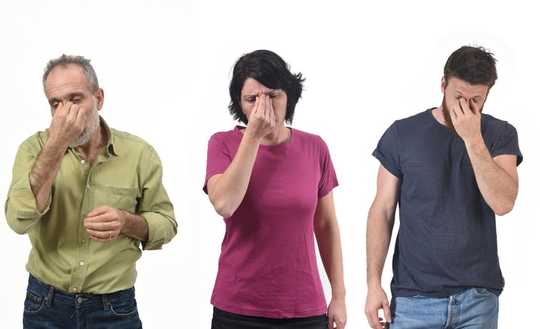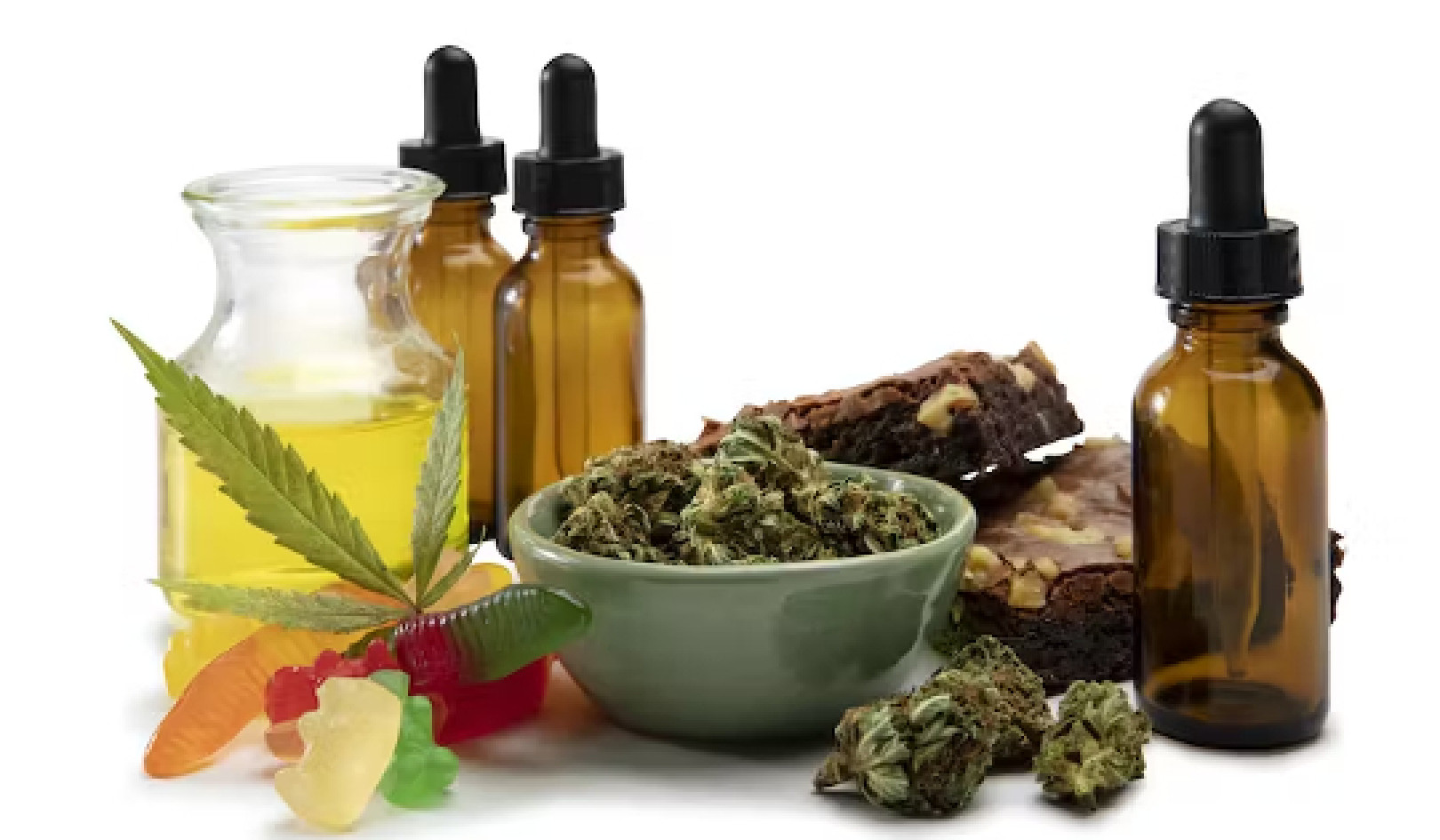 Touching one’s face is natural, but it spreads germs. There are ways to stop. Josep Curto/Shutterstock.com
Touching one’s face is natural, but it spreads germs. There are ways to stop. Josep Curto/Shutterstock.com
Public health officials consistently promote hand-washing as a way for people to protect themselves from the COVID-19 coronavirus. However, this virus can live on metal and plastic for days, so simply adjusting your eyeglasses with unwashed hands may be enough to infect yourself. Thus, the Centers for Disease Control and Prevention and the World Health Organization have been telling people to stop touching their faces.
We are experts in psychological science and public health. Brian Labus is an expert in communicable diseases who knows what people should do to avoid becoming infected. Stephen Benning is a clinical psychologist who helps clients change their habits and manage stress in healthy ways. Kimberly Barchard is an expert in research methods who wanted to know what the research says about face-touching. Together, we used our clinical expertise and the research literature to identify the best practices to reduce face-touching and lower people’s chances of catching COVID-19.
People touch their faces frequently. They wipe their eyes, scratch their noses, bite their nails and twirl their mustaches. People touch their faces more when they are anxious, embarrassed or stressed, but also when they aren’t feeling anything at all. Studies show that students, office workers, medical personnel and people on trains touch their faces between nine and 23 times per hour, on average.
Why is it so hard to stop? Face-touching rewards us by relieving momentary discomforts like itches and muscle tension. These discomforts usually pass within a minute, but face-touching provides immediate relief that eventually makes it a habitual response that resists change.
Stop touching your face, Uncle Bill! Do you want to get coronavirus? Brian Keith was always touching his face to show irritation, deep thought, resignation, exasperation, and various other emotions. He'd be having a hard time right now. #touchingyourface #familyaffair #classictv pic.twitter.com/2eBkeAsupn
— Michael's TV Tray (@michaelstvtray) March 7, 2020
Change habitual behaviors
Habit reversal training is a well-established behavior modification technique that helps people stop a variety of seemingly automatic behaviors, such as nervous tics, nail-biting and stuttering. It trains people to notice the discomfort that prompts their habits, select another behavior to use until the discomfort passes and change their surroundings to lessen their discomfort.
You may have already changed some of your other habits – for example, by coughing into your elbow instead of your hands, or greeting others with a bow or wave instead of a handshake. But unlike coughing and hand-shaking, people frequently touch their faces without being aware of doing so. So the first step in reducing face-touching is becoming aware of it.
Each time you touch your face, notice how you touched your face, the urge or sensation that preceded it and the situation you were in – what you were doing, where you were physically or what you were feeling emotionally. If you usually don’t notice when you touch your face, you can ask someone else to point it out.
Self-monitoring is more effective when people create a physical record. You can create a log where you briefly describe each instance of face-touching. For example, log entries might say:
• Scratched nose with finger, felt itch, while at my desk
• Fiddled with eyeglasses, hands tingled, frustrated
• Rested chin on palm, neck sore, while reading
• Bit fingernail, nail caught on pants, watching TV
Self-monitoring is more effective if people share their outcomes publicly, so consider sharing your results with friends or post it on social media.
Create new responses
Now that you are aware of the behavior you want to change, you can replace it with a competing response that opposes the muscle movements needed to touch your face. When you feel the urge to touch your face, you can clench your fists, sit on your hands, press your palms onto the tops of your thighs or stretch your arms straight down at your sides. This competing response should be inconspicuous and use a position that can be held for at least a minute. Use the competing response for as long as the urge to touch your face persists.
Some sources recommend object manipulation, in which you occupy your hands with something else. You can rub your fingertips, fiddle with a pen or squeeze a stress ball. The activity shouldn’t involve touching any part of your head. For tough-to-break habits, object manipulation isn’t as effective as competing responses, perhaps because people tend to play with objects when bored, but touch their faces and hair when anxious.
Learn more about breaking the itch-scratch cycle.
Manage your triggers
Changing your environment can reduce your urges to touch your face and your need to use alternative responses. Use your log to figure out what situations or emotions are associated with your face-touching. For example:
• If your glasses keep slipping off your nose, you can use ear hooks or hair ties to prevent slippage.
• If you bite your nails, you can use a file to keep your nails short, or wear gloves or fingertip bandages, so that nail-biting is impossible.
• If allergies make your eyes or skin itch or make your nose run, you can limit your exposure to allergens or take antihistamines.
• If you get food stuck between your teeth, you can brush your teeth after each meal.
• If your hair gets in your eyes and mouth, you can use an elastic, scarf or hair product to keep it back.
You can read more detailed information about habit reversal training.
Face it, you may not be able to stop
Most people cannot entirely eliminate unwanted habits, but they can reduce them. Consistent with the principles of harm reduction, just reducing face-touching lessens the opportunities for viruses to enter your system.
Sometimes you need to touch your face: flossing your teeth, putting in contact lenses, wiping food off your lips, putting on makeup or shaving your jaw. Remember to wash your hands first. To adjust your glasses without first washing your hands, use a tissue and throw it out immediately after use. Avoid finger food and using unwashed hands to put food into your mouth. Wash your hands first, or use utensils or the wrapper to handle the food.
Other ways you can reduce the spread of infectious diseases include practicing social spacing, washing hands thoroughly with soap and water or hand sanitizer and disinfecting high-touch surfaces regularly. When your hands touch contaminated surfaces, though, the suggestions above may help you avoid touching your face before you wash them again.
About The Author
Stephen D. Benning, Assistant Professor of Psychology, University of Nevada, Las Vegas; Brian Labus, Assistant Professor of Epidemiology and Biostatistics, University of Nevada, Las Vegas, and Kimberly A. Barchard, Professor of Quantitative Psychology, University of Nevada, Las Vegas
This article is republished from The Conversation under a Creative Commons license. Read the original article.

Related Books:
Atomic Habits: An Easy & Proven Way to Build Good Habits & Break Bad Ones
by James Clear
Atomic Habits provides practical advice for developing good habits and breaking bad ones, based on scientific research on behavior change.
Click for more info or to order
The Four Tendencies: The Indispensable Personality Profiles That Reveal How to Make Your Life Better (and Other People's Lives Better, Too)
by Gretchen Rubin
The Four Tendencies identifies four personality types and explains how understanding your own tendencies can help you improve your relationships, work habits, and overall happiness.
Click for more info or to order
Think Again: The Power of Knowing What You Don't Know
by Adam Grant
Think Again explores how people can change their minds and attitudes, and offers strategies for improving critical thinking and decision making.
Click for more info or to order
The Body Keeps the Score: Brain, Mind, and Body in the Healing of Trauma
by Bessel van der Kolk
The Body Keeps the Score discusses the connection between trauma and physical health, and offers insights into how trauma can be treated and healed.
Click for more info or to order
The Psychology of Money: Timeless lessons on wealth, greed, and happiness
by Morgan Housel
The Psychology of Money examines the ways in which our attitudes and behaviors around money can shape our financial success and overall well-being.






















